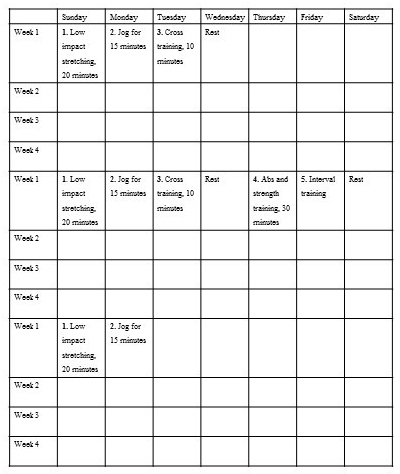The biggest challenge with typical exercise programs is that by Tuesday of Week 2 most will have given up. We give up because our schedules get in the way, our motivation wanes, or our bodies resist. “Staying on” most programs is undoable for most folks who lead busy lives nowadays.
Importantly, though, when we give up on these rigid schedules, it’s not the calorie burns from the rest of the workouts missed that really matters – it’s the effect on our bodies that would have taken place in between if someday we would have done workouts three and four. When it comes to exercise, we really shouldn’t care about keeping a schedule, but instead care about the long term beneficial effects on our health – even if it means only 20 workouts in 90 days.
Consider the program in the figure below. It represents a typical “30 day” program available on most websites, in most books, etc. There is no reasonable person who will say that at the end of these 30 days, if we complete this program, that we will not have burned a lot of calories. So, from the traditional standpoint, this is solid. (Not surprisingly, someone is probably considering trying this, huh? Ugh. . . . please read on)

If it were possible to stick to this program, we would certainly glean the benefits of burning calories on those days, through those exercises and no doubt additional intake restrictions. But, chances are we cannot do this program as is – so we end up quitting altogether and miss the important benefits beyond calorie burning. We don’t need these workouts so much to burn the 200 calories each, but to increase our heart rate, improve our air exchange, and a host of other benefits that occur in-between the actual exercise episodes.
Let’s look at this program from a different perspective. Over 3 months, here is what most people from the general population typically get done using the “start over” method (and you can imagine the same thing over 6 months, a year, two years. . .)

Now let’s change the way we react when we feel like quitting. Instead of bailing and starting over weeks down the road, let’s try a different approach. If we miss workout 3, it’s not over – we take a few days off, and then come back to workout 3 (we don’t give up altogether only to start at the beginning some day down the road – we employ a No Restart rule). Depending on how we feel in the following days, we get to workout 4 at some point. We don’t care about keeping a schedule, we care about changing internally – and here is how. Consider the same 90 days, but using the no restart principle. It will look something like this.

Now, calorie-wise this is much better of course – and we can add that up to be complete. But the real value is that if we do it this way, and we get to work out 20, we create in-between days that allow us to build a bridge to long-term healthy living.
This is the critical point. Following a quit and restart, the in between time is blank, worthless. Adhering to the no restart creates value for our in between days, which is what is really missing for so many of us. These otherwise hidden days are highlighted in our new table. By implementing the No Restart principle, you can unlock all of these days, create new space for healthy living, and make three times as much progress than without it. Best of luck my good friends!

